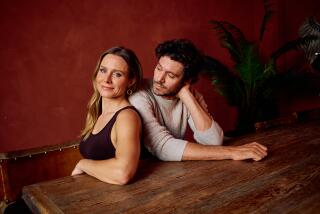Broderick Judge Gives 5 Options as Jury Gets Case : Trial: The La Jolla socialite makes her court appearance in jail clothes and calls it a protest against rulings that suppressed information during her murder trial.
- Share via
As jurors began deciding her double-murder trial, La Jolla socialite Elisabeth Anne (Betty) Broderick showed up in court Thursday wearing jail-issue sweat clothes to protest what she viewed as unfair treatment during the case.
Upset at rulings that kept from jurors almost all of her secret diaries and the extensive file from a bitter divorce, Broderick wore a gray sweat shirt, blue sweat pants and sneakers to face the jury for the final time before it got the case.
“I’m protesting,” she whispered to reporters.
San Diego Superior Court Judge Thomas Whelan, who made the rulings barring the bulk of the diaries and the file, did not say anything to the jurors about Broderick’s choice of dress. He instructed them on their five options in the case--two levels of murder, two degrees of manslaughter and not guilty on any charges--and told them to begin deciding it.
Betty Broderick, 43, is charged with two counts of first-degree murder in the Nov. 5, 1989, shooting deaths of her ex-husband, attorney Daniel T. Broderick III, and his new wife, Linda Kolkena Broderick.
Betty Broderick has pleaded not guilty and has been held at the Las Colinas Jail in Santee since she turned herself in to police hours after the killings. She could be sentenced to life in prison without parole.
Daniel Broderick, who was 44, was a prominent medical malpractice attorney and a former president of the San Diego County Bar Assn. Linda Kolkena Broderick, who was 28, was his office assistant.
After 16 years of marriage, Betty and Daniel Broderick separated in 1985. During and after their bitter divorce, which took four years to conclude, she accused him of cheating her out of her fair share of his million-dollar annual income.
Betty Broderick admits firing the shots that killed her ex-husband and his second wife. She contended at the trial that she did not have the premeditation the law requires for first-degree murder because she intended only to confront him and to kill himself last Nov. 5, when she stole into his house before dawn.
Deputy Dist. Atty. Kerry Wells, the prosecutor in the case, contends that Betty Broderick fully intended the killings and executed her ex-husband and his new wife after years of rising rage that stemmed from the divorce.
Whelan told jurors Thursday that their five options in the case are first- and second-degree murder, voluntary and involuntary manslaughter and not guilty on any charges.
First-degree murder means the murder was premeditated--or considered beforehand--while second-degree lacks that deliberation. Voluntary manslaughter means a killing was considered after a sudden provocation. Involuntary manslaughter describes a killing that occurs while doing something else without due caution.
Through her choice of clothes, Betty Broderick contended Thursday that the jury wasn’t being given all the facts it needed to make a fair decision, Earley said. She had the choice of wearing dress clothes, as she had for each prior day in the trial, but opted for the sweats, both shirt and pants stenciled with “SD JAIL” in big letters.
“I’m upset that the diaries didn’t come in,” she whispered, pointing to a stack of notebooks, “and the divorce verdict not being put into evidence,” an apparent reference to the divorce file--not the verdict--because the divorce judgment itself is part of the evidence in the murder case.
The diaries corroborated her testimony in the case about her motives and emotions, defense lawyer Jack Earley said.
Whelan, however, ruled that the notebooks--in all, about 10 volumes, which Betty Broderick kept from 1985, when she and Daniel Broderick separated, until 1988--were too cumbersome for the jury to pore through.
One excerpt from the diaries did go to the jury, introduced by prosecutor Wells. In that excerpt, Betty Broderick wrote that “there is no better reason to kill” than to protect home and family, and said her ex-husband had “attacked and destroyed” her and the couple’s four children.
Betty Broderick feels it is unfair for the jury to see that excerpt out of context, Earley said.
She believes the divorce file is also crucial to an understanding of the context of the murder case because it documents the history of her battles with her ex-husband, Earley said.
Betty Broderick, he said, believes the file would help explain her allegations that her ex-husband manipulated the legal system against her, and why she did certain things she did during the divorce--like drive her car into his front door after he engineered the court-ordered sale of her house.
The divorce file is sealed to the public and press.
Earley said he did not believe Betty Broderick’s clothes were a sign that she was upset with the way he handled the case. Instead, she simply felt she no longer had “any reason to go ahead with the trial process,” he said.
Both Earley and Wells declined to speculate how long the jury might be out.
“You hope the jury is out long enough to address the issues,” Earley said.
Both attorneys also said they did not want to predict the verdict.
More to Read
Sign up for Essential California
The most important California stories and recommendations in your inbox every morning.
You may occasionally receive promotional content from the Los Angeles Times.













